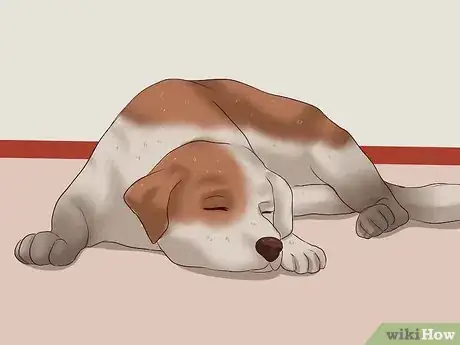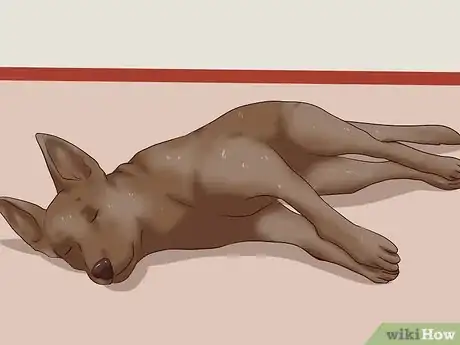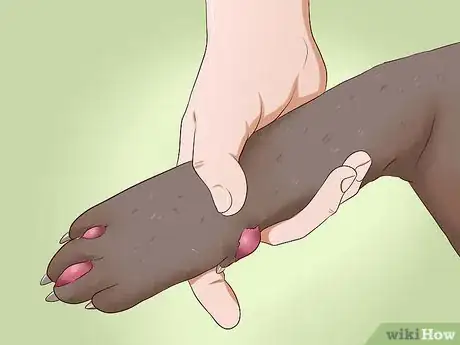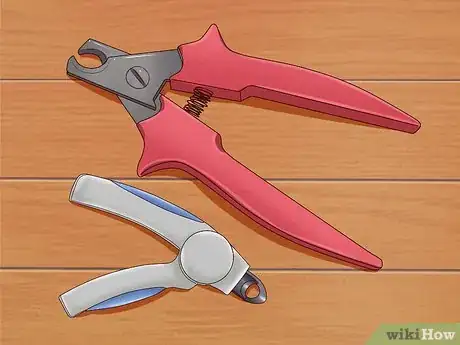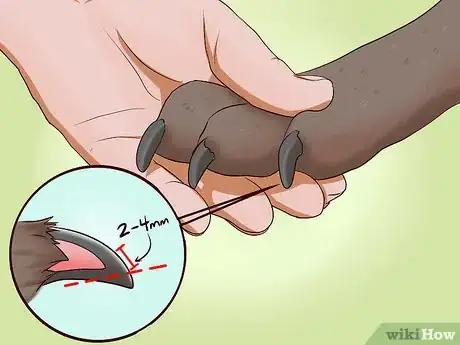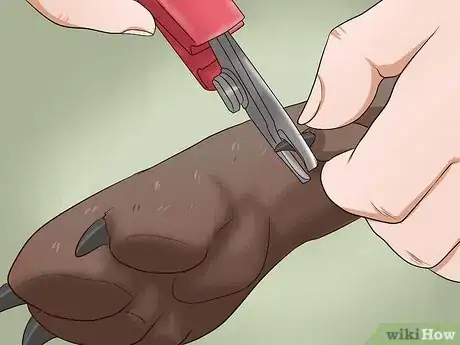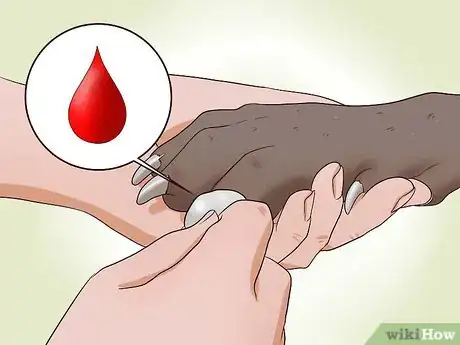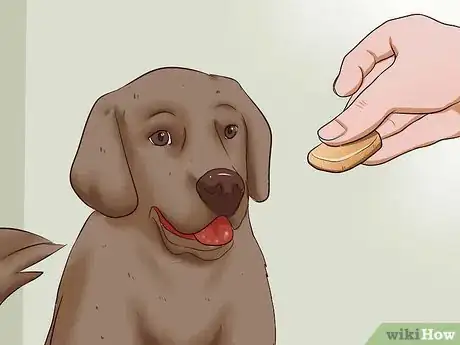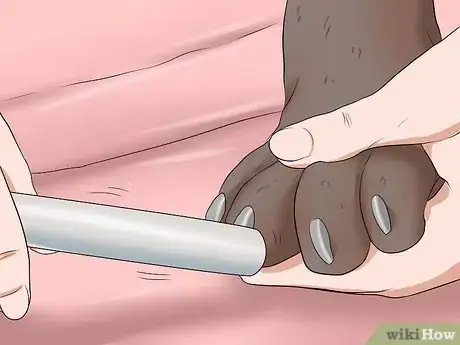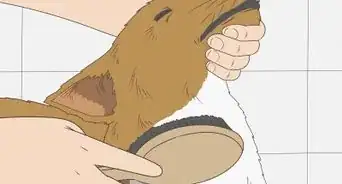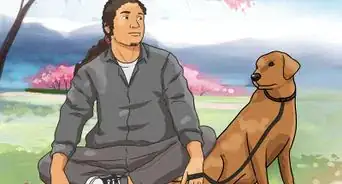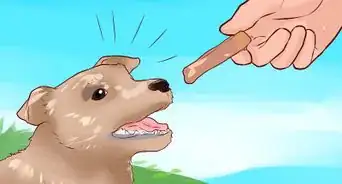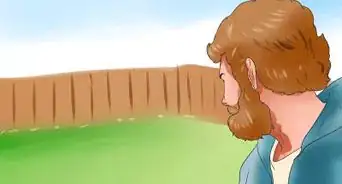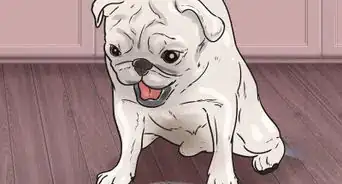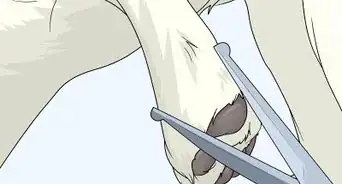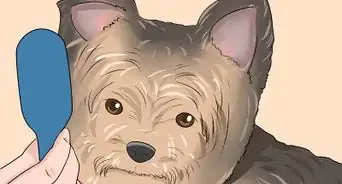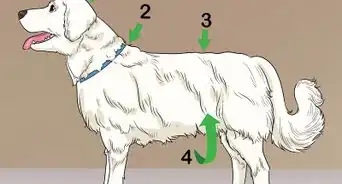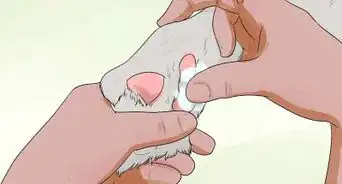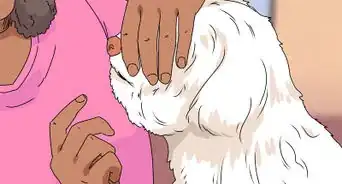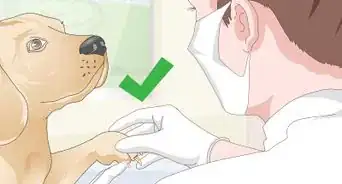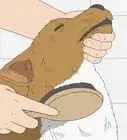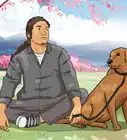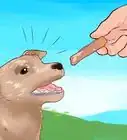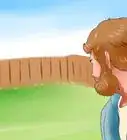This article was co-authored by Pippa Elliott, MRCVS. Dr. Elliott, BVMS, MRCVS is a veterinarian with over 30 years of experience in veterinary surgery and companion animal practice. She graduated from the University of Glasgow in 1987 with a degree in veterinary medicine and surgery. She has worked at the same animal clinic in her hometown for over 20 years.
wikiHow marks an article as reader-approved once it receives enough positive feedback. In this case, 92% of readers who voted found the article helpful, earning it our reader-approved status.
This article has been viewed 317,435 times.
Nail trimming is an important task that keeps your dog’s nails short and healthy. It also keeps your floors and furniture safe from snags and scratches! Long nails can break and bleed, or they can grow back into the paw and cause pain. They can also make a dog lame if they interfere with normal paw movement. Regular nail trimming will prevent these problems and give you a chance to check the nails for any abnormalities.
Steps
Getting Your Dog Used to Handling
-
1Choose the right time. Most dogs do not like nail trims, so it's important to choose a time when your dog is relaxing. If he's in the mood to play, wait until he's lounging before approaching him for paw-handling training.
-
2Ease into paw handling. Start by touching your dog's paws gently. If he doesn’t pull away or resist, start massaging the paw and gently pressing on his nails. Depending on your dog’s age and temperament, it may take a few sessions before he's used to paw handling. Repeat this exercise a few times daily until your dog stops reacting to paw handling.Advertisement
-
3Teach your dog to lie on his side during trims if necessary. If your dog's had a bad experience in the past, he may resist nail trims. For example, if someone accidentally cut the "quick" (an area of the nail with a rich blood and nerve supply), he would have experienced pain and bleeding. Older dogs may have arthritis in their toes, and nail trimming may be uncomfortable. For dogs like this, it can be helpful to have them lie down while you carefully handle their nails.
- Have them lie on their side while you do your paw-handling training exercises.
- Another way is to trim the nails while the dog is standing without lifting up the paw. Only do this if you are experienced with trimming nails.[1]
-
4Inspect the paws for abnormalities.[2] As you are massaging the paws and nails, take the opportunity to examine their health. Bring any pain, sore or raw spots, nail breakage, swelling or redness, lameness, or odd nail color to the attention of your veterinarian before you attempt to trim the nails.[3] Trauma, infections, tumors, and immune diseases are the most common nail disorders in dogs.
- Trauma usually only occurs in one nail and is caused by running on rough surfaces, catching a nail on an object, or improper nail trimming.
- Trauma or health conditions like diabetes and low thyroid levels can lead to bacterial infection in the nail. Bacterial infections usually cause swelling, pain, and discharge around the nails.
- Fungal and parasitic infections are less common than bacterial infections but cause similar symptoms.
- Tumors can take different forms: lumps, bumps, swellings, redness, or discharge.
- Immune disease can also affect the nail and may make the nail brittle and prone to sloughing.
- Always bring these findings to the attention of your veterinarian as soon as possible for treatment.
Trimming the Nails
-
1Use clippers made specifically for dogs.[4] Human clippers are designed for a flat surface area, but dog nails are cupped. Using human clippers can squish the nail, causing pain or injury. There are a few different types of dog nail trimmers, the most common being either the guillotine (U shaped) or the scissors type. Which type to use is generally a matter of preference for the user.
- The "scissors" might be easier to use, as you don't need to thread the nail through the cutting surface as with the guillotine.
-
2Locate the quick. The quick is the part of the nail rich in blood supply and nerves. Cutting into it can be quite painful for the dog, and cause bleeding. Ideally, you should trim the nail back to within 2-4 millimeters of the quick.
- If your dog has white nails, you should be able to see the pink-colored quick through the nail.
- If your dog has dark nails you won't be able to see the quick. Carefully trim the nails back a little at a time to avoid cutting into it.[5] You might have a groomer or vet show you how far to trim the nails.
- If a dog’s nails grow too long, the quick will grow with it. Frequent trimmings will make the quick recede back to a normal length.
-
3Secure the dog. If the dog's relaxed and used to having its paws and nails handled, just have your dog lie down for its nail trimming. If he gets antsy, restrain him gently in the lying position using the elbow and arm that's holding his paw.
- If you have a very wriggly dog, ask a second person to help you out. Have your friend hold the dog while you're free to focus on the trimming.
-
4Start with the back paws. The nails on the back paws are usually shorter and easier to trim. Dogs also tend to be a bit calmer about having their back paws manipulated than their front paws, so start there, then move on to the front paws.
- Locate or approximate the quick before trimming off the end of the nail.
- Carefully work your way back towards the quick and stop trimming 2-3 millimeters in front of it.
- Don’t forget to trim the dewclaws on dogs that have them. Dewclaws are the nails some dogs have on the inside of the leg, just above the "wrist."[6]
-
5Stop any bleeding if you cut into the quick. A cut quick usually bleeds a lot, and your dog may cry out in pain or nip at you if this happens. If you accidentally cause bleeding, hold a piece of tissue onto the nail for a few minutes. If that doesn't stop bleeding, apply cornstarch or a commercial stop-bleeding powder or pen. Either dip the nail into the powder or apply a large amount using your fingertip.
- If bleeding doesn’t stop after 10 minutes, call your vet.
-
6Praise your dog frequently.[7] A lot of praise, and if you wish, a little treat, is a great incentive to stand still. Praise throughout the process, and give a treat after you finish working on each paw.
-
7File the nails if desired. Just like human nails, dog nails can be rough and abrasive when they're freshly cut. They will wear down on their own with time. But, if you're worried about your floors or furniture, you can choose to file the nails immediately to round them off.
Expert Q&A
Did you know you can get expert answers for this article?
Unlock expert answers by supporting wikiHow
-
QuestionHow do I trim my dog's nails when they're black?
 Lancy WooLancy Woo is a Certified Pet Groomer and the Owner of VIP Grooming, a pet grooming salon based in San Francisco, California. VIP Grooming has served San Francisco for over 35 years. Lancy received her pet grooming certification from the WWPSA (Western Word Pet Supply Association). VIP Grooming has been voted "Best in the Bay" in 2007, 2010, 2011, 2014, 2017, 2018, and 2019 and won Bay Woof’s "Beast of Bay" in 2014. In 2018, Lancy's work contributed to VIP Grooming's acceptance onto San Francisco's Office of Economic and Workforce Development's Legacy Business Registry.
Lancy WooLancy Woo is a Certified Pet Groomer and the Owner of VIP Grooming, a pet grooming salon based in San Francisco, California. VIP Grooming has served San Francisco for over 35 years. Lancy received her pet grooming certification from the WWPSA (Western Word Pet Supply Association). VIP Grooming has been voted "Best in the Bay" in 2007, 2010, 2011, 2014, 2017, 2018, and 2019 and won Bay Woof’s "Beast of Bay" in 2014. In 2018, Lancy's work contributed to VIP Grooming's acceptance onto San Francisco's Office of Economic and Workforce Development's Legacy Business Registry.
Certified Pet Groomer
-
QuestionAre my dog's toenails too long?
 Pippa Elliott, MRCVSDr. Elliott, BVMS, MRCVS is a veterinarian with over 30 years of experience in veterinary surgery and companion animal practice. She graduated from the University of Glasgow in 1987 with a degree in veterinary medicine and surgery. She has worked at the same animal clinic in her hometown for over 20 years.
Pippa Elliott, MRCVSDr. Elliott, BVMS, MRCVS is a veterinarian with over 30 years of experience in veterinary surgery and companion animal practice. She graduated from the University of Glasgow in 1987 with a degree in veterinary medicine and surgery. She has worked at the same animal clinic in her hometown for over 20 years.
Veterinarian
-
QuestionCan I use a nail file?
 Pippa Elliott, MRCVSDr. Elliott, BVMS, MRCVS is a veterinarian with over 30 years of experience in veterinary surgery and companion animal practice. She graduated from the University of Glasgow in 1987 with a degree in veterinary medicine and surgery. She has worked at the same animal clinic in her hometown for over 20 years.
Pippa Elliott, MRCVSDr. Elliott, BVMS, MRCVS is a veterinarian with over 30 years of experience in veterinary surgery and companion animal practice. She graduated from the University of Glasgow in 1987 with a degree in veterinary medicine and surgery. She has worked at the same animal clinic in her hometown for over 20 years.
Veterinarian Absolutely. A coarse emery board or a nail file is a great option if you don't feel confident to trim the nails. Don't feel you need to do all the nails in one go, instead, do one or two toes each evening when the dog is relaxed beside you. You can also purchase mini-grinders that are designed for this purpose.
Absolutely. A coarse emery board or a nail file is a great option if you don't feel confident to trim the nails. Don't feel you need to do all the nails in one go, instead, do one or two toes each evening when the dog is relaxed beside you. You can also purchase mini-grinders that are designed for this purpose.
Warnings
- Cutting into the "quick" of the nail and not cleaning the cut can lead to infection.⧼thumbs_response⧽
- DO NOT cut the dog's blood vessel inside the nail!⧼thumbs_response⧽
- Always clean and disinfect the clippers after each use to prevent the spread of infection.⧼thumbs_response⧽
- If you notice the dog limping after you trim the nails, consult your veterinarian.⧼thumbs_response⧽
- Ingrown nails should be examined by a vet, and should not be clipped beforehand by the owner.⧼thumbs_response⧽
Things You'll Need
- Dog nail clippers
- Dog nail file
- Cornstarch or commercial stop-bleeding powder or pen (if you cut into the quick)
References
- ↑ The Everything Dog Grooming Book. Sandy Blackburn. F + W Publications, Inc.
- ↑ Nail diseases. CVC in Washington, D.C. Proceedings. April 1, 2010. Patrick Hensel, DVM, DACVD.
- ↑ Handbook of Veterinary Procedures and Emergency Treatment. Ford and Mazzaferro. Elsevier, Inc.
- ↑ Lancy Woo. Certified Pet Groomer. Expert Interview. 26 February 2020.
- ↑ Lancy Woo. Certified Pet Groomer. Expert Interview. 26 February 2020.
- ↑ http://dogcare.dailypuppy.com/purpose-dewclaw-dogs-2110.html
- ↑ Lancy Woo. Certified Pet Groomer. Expert Interview. 26 February 2020.
About This Article
To trim your dog's nails, use nail clippers designed specifically for dogs since human clippers can cause pain or injury. If your dog doesn't like its nails to be clipped, gently restrain it while it's lying down and use your elbow and arm to hold its paw. Then, use the clippers to trim each nail back to within 2-4 millimeters of the quick, which is the pink-colored vein inside of the nail. If you can't see the quick, only trim your dog's nails back a little bit at a time so you don't accidentally cut into it. For tips on getting your dog used to having its nails trimmed, keep reading!
